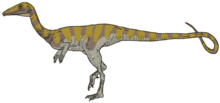Camposaurus
|
Camposaurus Temporal range: Late Triassic, 220 Ma |
|
|---|---|
 |
|
| Reconstruction based on holotype specimen, with unknown elements after Coelophysis. | |
| Scientific classification | |
| Kingdom: | Animalia |
| Phylum: | Chordata |
| Class: | Reptilia |
| Clade: | Dinosauria |
| Order: | Saurischia |
| Suborder: | Theropoda |
| Family: | †Coelophysidae |
| Subfamily: | †Coelophysinae |
| Genus: |
†Camposaurus Hunt et al., 1998 |
| Type species | |
|
†Camposaurus arizonensis Hunt et al., 1998 |
|
Camposaurus (/kæmpoʊsɒrʌs/ "CAMP-oh-SORE-us"; meaning "Charles Lewis Camp's lizard") is a coelophysoid dinosaur genus from the Norian stage of the Late Triassic period of North America. The pertinent fossil remains date back to the early to middle Norian stage, and is widely regarded as the oldest known neotheropod.
Camposaurus is a small, carnivorous, theropod dinosaur. Its approximate length and weight cannot be reliably estimated because of the sparse material that is known from this genus. Camposaurus is known from partial lower leg bones, holotype UCMP 34498 (which includes distal tibiae, distal fibulae, and astragalocalcanea), and other fragmentary material. Like other coelophysids, it has fused tibio-tarsals and fibulo-tarsals. Unlike its relatives, the area of the tibia that fits with the fibula has a distinct ridge at the back. Another unique feature is the lack of a large medial condyle on the astragalus. The type species, C. arizonensis, was formally named and described by Adrian Hunt, Spencer G. Lucas, Andrew B. Heckert, Robert M. Sullivan and Martin Lockley in 1998. As the species name suggests, it was found in Arizona, in the United States.
...
Wikipedia
